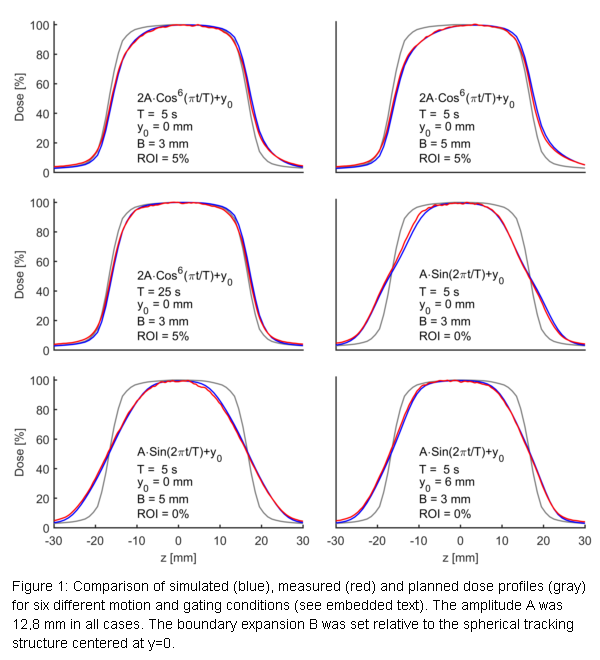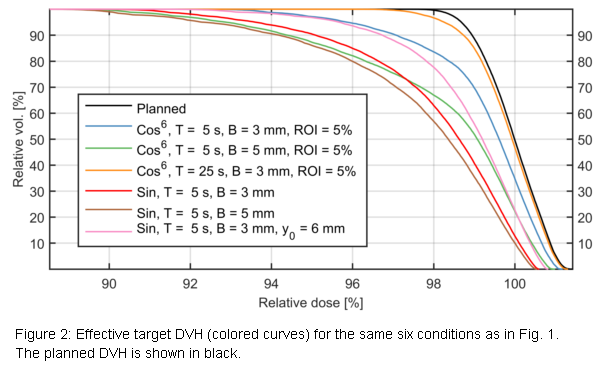The impact of gating methodology on target coverage: Simulations and measurements on an MR linac
PO-1709
Abstract
The impact of gating methodology on target coverage: Simulations and measurements on an MR linac
Authors: Kristian Boye1, Cécile Peucelle1, Juliette Myxa2, Laia Poqui i Sallés3, Isak Wahlstedt1
1Copenhagen University Hospital - Rigshospitalet, Department of Oncology, Copenhagen, Denmark; 2Aix-Marseille University, Polytech Marseille, Marseille, France; 3DTU, Health Technology, Roskilde, Denmark
Show Affiliations
Hide Affiliations
Purpose or Objective
Magnetic resonance-guided RT (MRgRT) is an attractive treatment for abdominal tumors due to superior soft tissue contrast. A further advantage of the Viewray MRIDian linac is automated beam-gating based on continuous 2D imaging (ciné) and real-time target tracking. This offers a prospect of treatment margin reduction. Although the PTV required to cover a moving target obviously depends on the gating window (boundary) and the respiratory motion, the exact relation is not yet known. To address this, we developed a Matlab model that predicts the effective dose distribution to a gated target with a known motion pattern. This work validates the model experimentally with film dosimetry.
Material and Methods
Longitudinal target motion was simulated in a dynamic phantom (CIRS 008A) equipped with a software-controlled, movable piston. An EBT3 Gafchromic film strip was placed in a nylon holder and inserted into a longitudinal cavity of the piston. A conformal stereotactic plan was prepared for a 3 cm Ø virtual target on the film plane with 3.4 Gy mean dose per fraction. During plan delivery, the piston moved with a breathing pattern defined by either a Cos6 (breath-holds) or a Sin (free breathing) function. Gating was performed on a high contrast sphere near the target, and individual fractions were delivered for 16 gating conditions, varying boundary expansion (B), position offset (y0), area threshold (ROI%), ciné frame rate and motion period (T). The exposed films were converted to dose profiles via the RadioChromic.com dosimetry protocol.
Each condition was simulated using our model. From known breathing patterns and gating conditions, the model can predict actual beam-on positions during treatment delivery and hence (by positional convolution) estimate the effective longitudinal dose profile from the planned one. Actual beam-on positions deviate from the allowed positions defined by the set boundary and ROI% due to tracking inaccuracies, imaging acquisition and processing time. The latter parameters were encompassed in the model and tuned to get the best possible overlay between predicted and measured profiles. The effective DVH for the target was also computed for each condition and compared to the plan DVH.
Results
The measured and simulated dose profiles are shown for six of the 16 conditions in Fig. 1. In general, good agreement is observed for both the free breathing (Sin) and the breath-hold motion pattern (Cos6). Five of the shown cases represent non-optimal clinical conditions, whereas the T = 25 s case is a more realistic situation, for which our model predicts a moderate reduction in target coverage (Fig. 2).


Conclusion
We observed clear dosimetric variations depending on the gating method, which was reproducible between film measurements and simulations. In the future, our model will be applied to clinical tracking data to prospectively assess patient-specific PTV margins. Such simulations may be necessary to ensure accurate dose delivery in challenging cases on the MR linac.